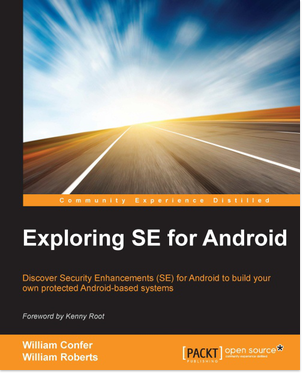Confer co-authors security book with alum
Exploring SE for Android, a book co-authored by William “Amos” Confer, assistant professor of computer and information sciences, and William Roberts, an alumnus with a master of science in computer science, has been published by PACKT publishing, Birmingham, U.K. The book is available at https://www.packtpub.com/networking-and-servers/exploring-se-android. “Our book not only introduces the reader to the Security Enhancements (SE) for Android open-source project, it walks through the process of securing new embedded systems with SE for Android. To our knowledge, this book is the first source to document such a process in its entirety, so that students, DIY hobbyists, and engineers of emerging areas where Android is seeing growth can produce products secured by SE for Android,” Confer says. “Traditionally, only OEMs such as Samsung or Cisco can do this, and most commonly, the target device is a phone or tablet. We hope our book will change that, engaging a very wide audience in developing and understanding modern security tools.”
 Confer’s co-author, William Roberts G’11, is a founding engineer for Samsung’s KNOX Android security product and a security consultant for companies including Intel. Confer says the book not only introduces the reader to the Security Enhancements (SE) for Android open-source project, it walks through the process of securing new embedded systems with SE for Android. It’s the first source to document such a process in its entirety, so that students, DIY hobbyists, and engineers of emerging areas where Android is seeing growth can produce products secured by SE for Android.
Confer’s co-author, William Roberts G’11, is a founding engineer for Samsung’s KNOX Android security product and a security consultant for companies including Intel. Confer says the book not only introduces the reader to the Security Enhancements (SE) for Android open-source project, it walks through the process of securing new embedded systems with SE for Android. It’s the first source to document such a process in its entirety, so that students, DIY hobbyists, and engineers of emerging areas where Android is seeing growth can produce products secured by SE for Android.
 “Traditionally, only OEMs such as Samsung or Cisco can do this, and most commonly, the target device is a phone or tablet,” Confer says. “We hope our book will change that, engaging a very wide audience in developing and understanding modern security tools. We worked very hard to ensure this text is not just another step-by-step technology book, though. In fact, it was my co-author’s idea to model the book after the way I teach many of my courses, directing the reader to fail their way to success. We first give them the appropriate theoretical understanding of how security is gained and enforced, then throw a system at them that has never been secured that way (not even by us prior to writing the book). We then guide the reader through all our intelligent guesswork, embracing unexpected failures for the newly found idiosyncrasies they expose, and eventually enforcing our custom security policies.”
“Traditionally, only OEMs such as Samsung or Cisco can do this, and most commonly, the target device is a phone or tablet,” Confer says. “We hope our book will change that, engaging a very wide audience in developing and understanding modern security tools. We worked very hard to ensure this text is not just another step-by-step technology book, though. In fact, it was my co-author’s idea to model the book after the way I teach many of my courses, directing the reader to fail their way to success. We first give them the appropriate theoretical understanding of how security is gained and enforced, then throw a system at them that has never been secured that way (not even by us prior to writing the book). We then guide the reader through all our intelligent guesswork, embracing unexpected failures for the newly found idiosyncrasies they expose, and eventually enforcing our custom security policies.”
“Writing the book has been a real joy, not only because I can bring one of my favorite classroom techniques to a larger audience, but also because it allowed me to deepen a relationship with an alum.”
Recent Comments
Archives
- September 2018
- August 2018
- May 2018
- April 2018
- March 2018
- February 2018
- January 2018
- December 2017
- November 2017
- October 2017
- September 2017
- May 2017
- April 2017
- March 2017
- February 2017
- January 2017
- December 2016
- November 2016
- October 2016
- September 2016
- August 2016
- May 2016
- April 2016
- March 2016
- February 2016
- January 2016
- December 2015
- November 2015
- October 2015
- September 2015
- August 2015
- May 2015
- April 2015
- March 2015
- February 2015
- January 2015
- December 2014
- November 2014
- October 2014
- September 2014
- August 2014
- May 2014
- April 2014
- March 2014
- February 2014
- January 2014
- December 2013
- November 2013
- October 2013
- September 2013
- August 2013
- June 2013
- May 2013
- April 2013
- March 2013
- February 2013
- January 2013
- December 2012
- November 2012
